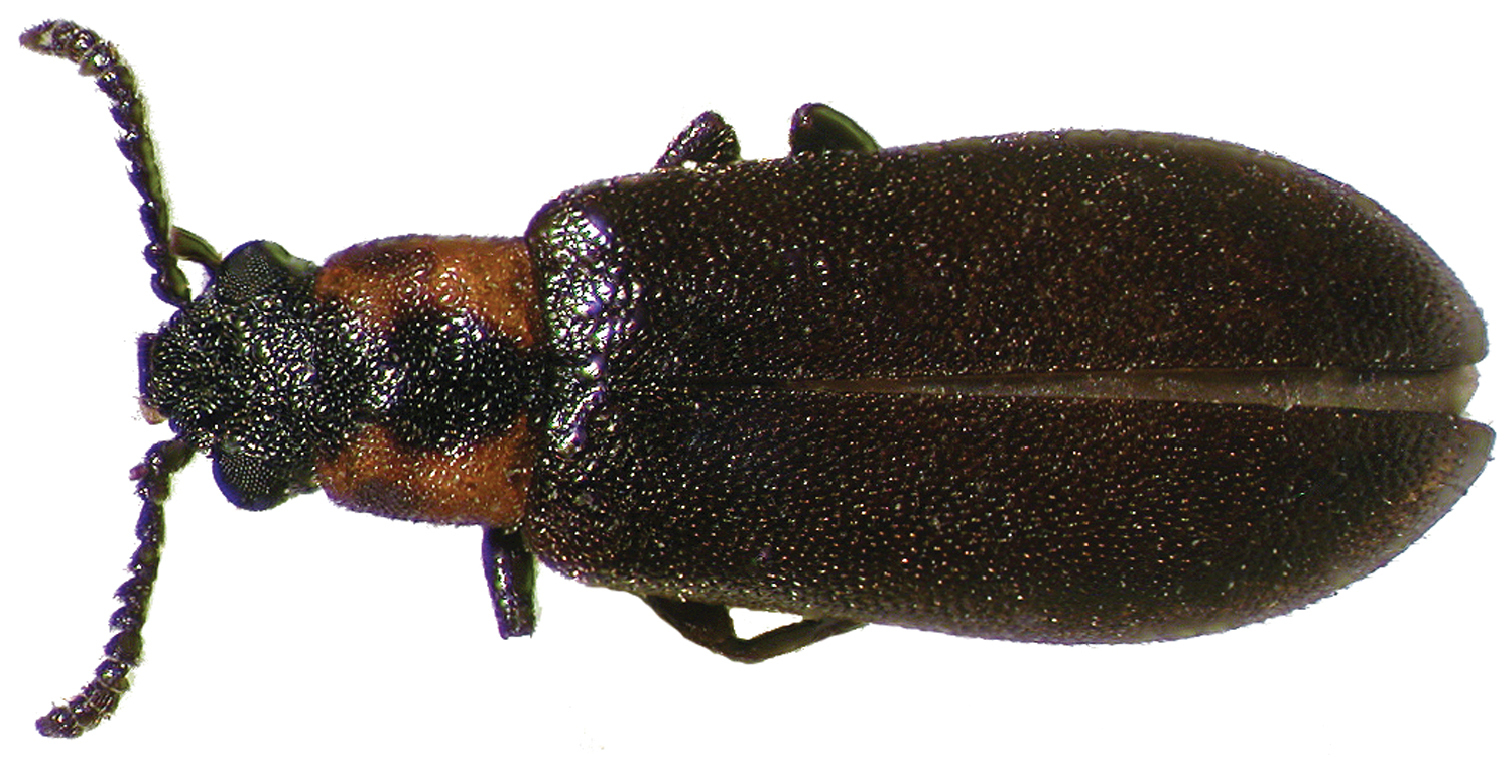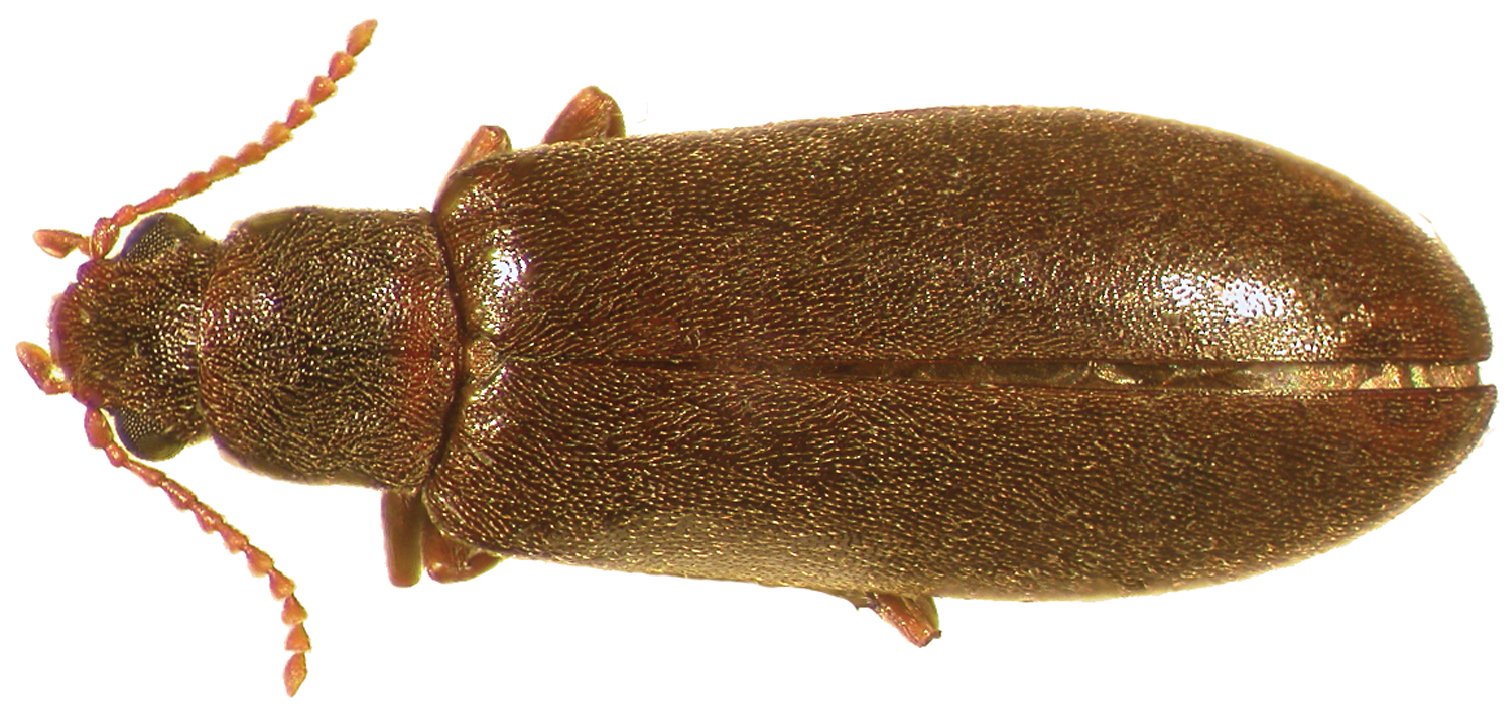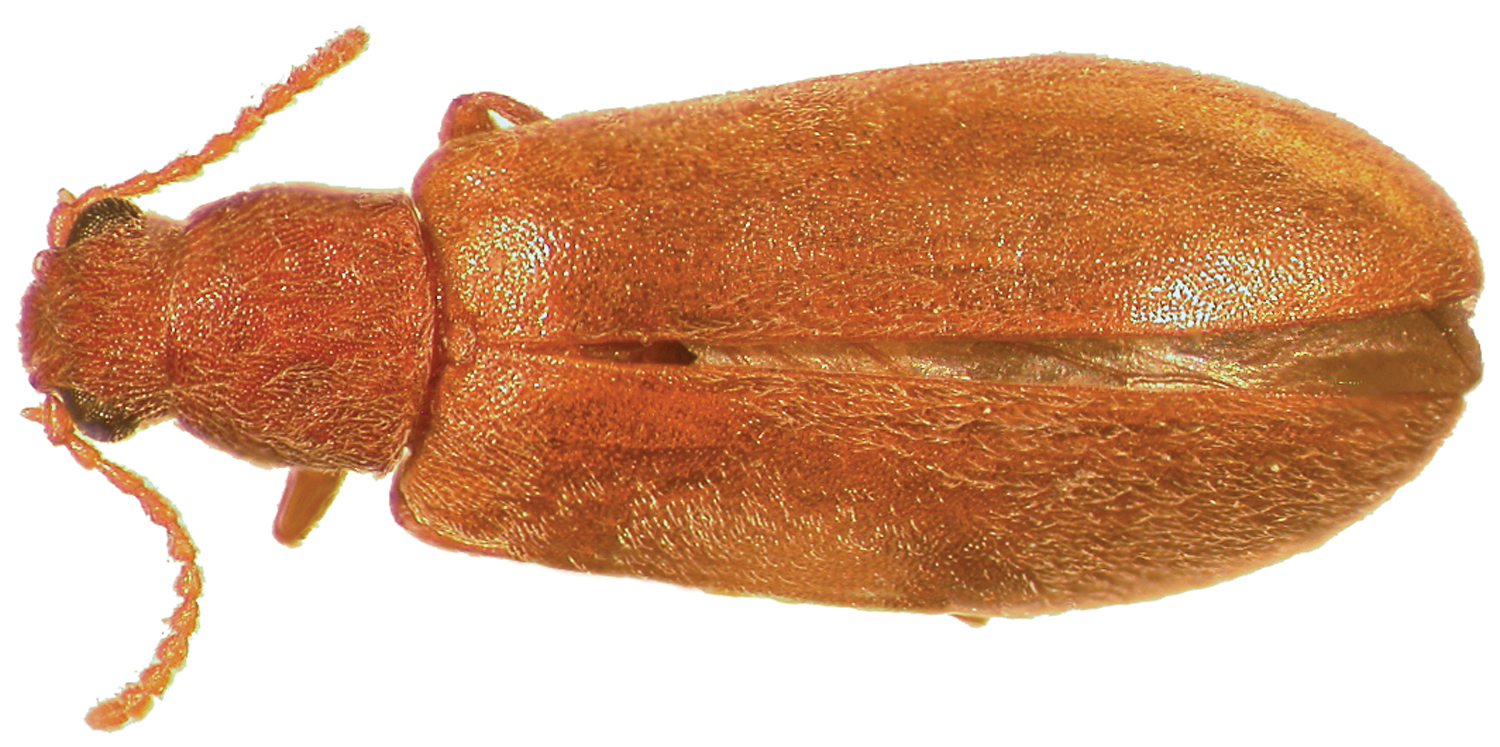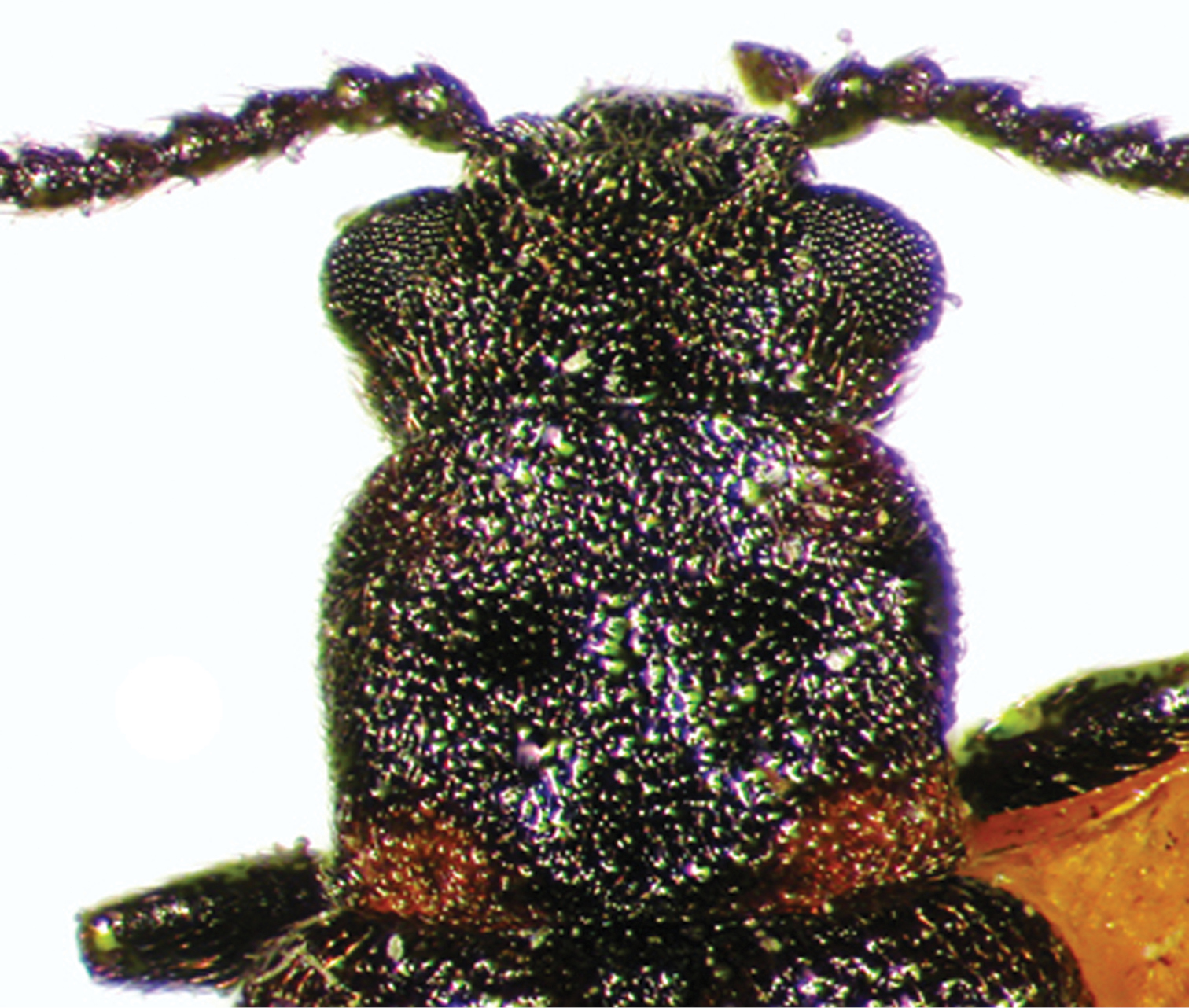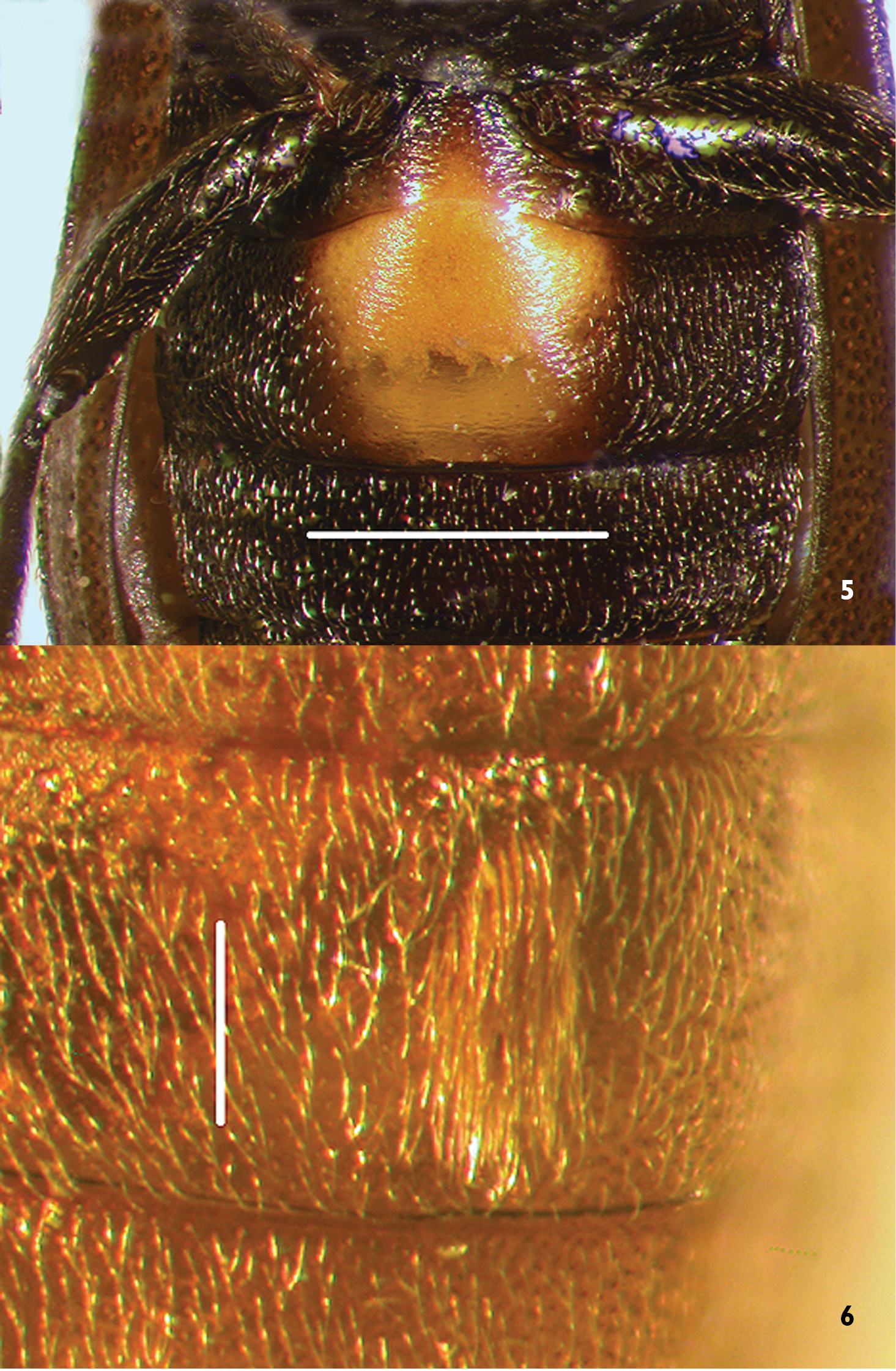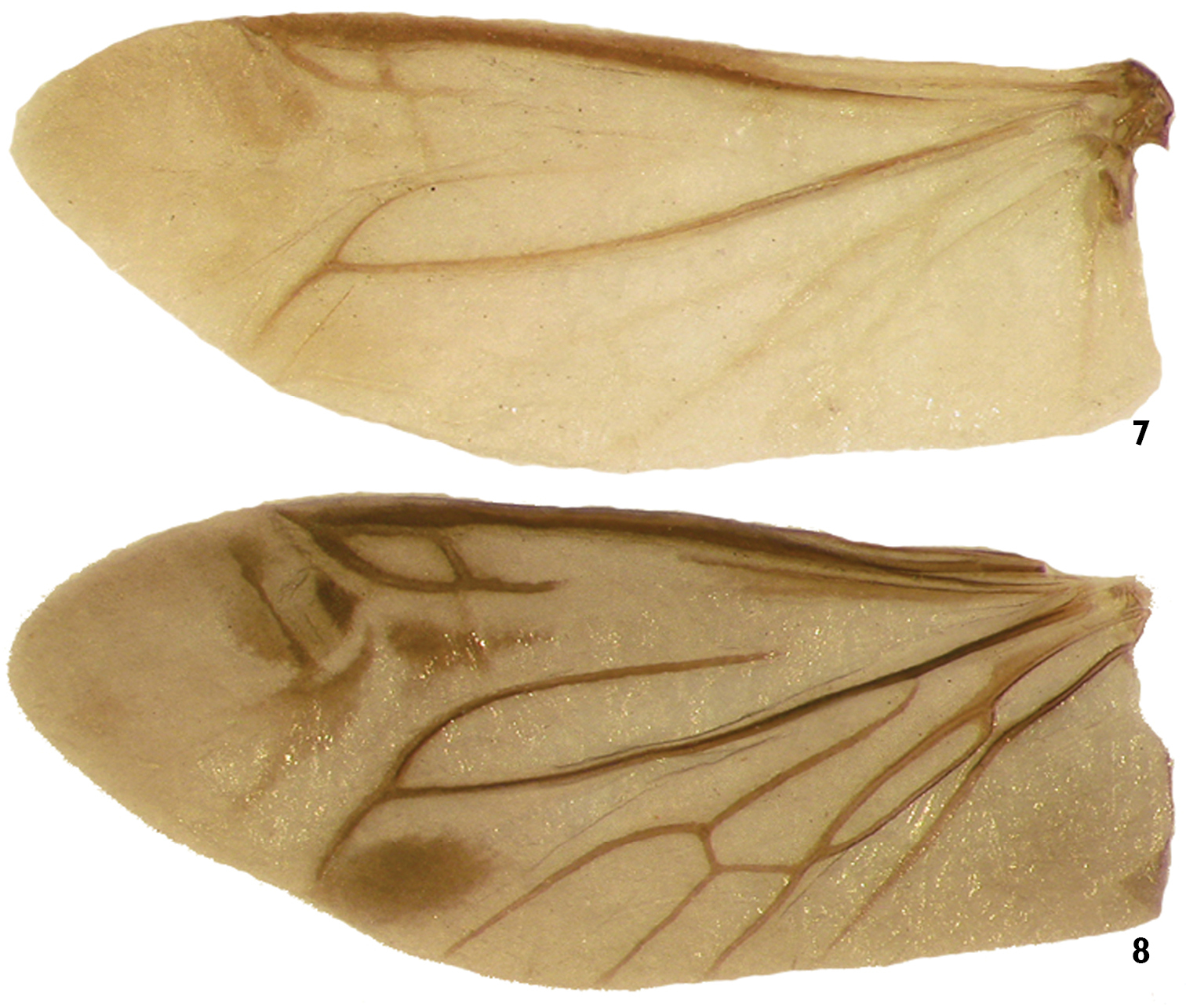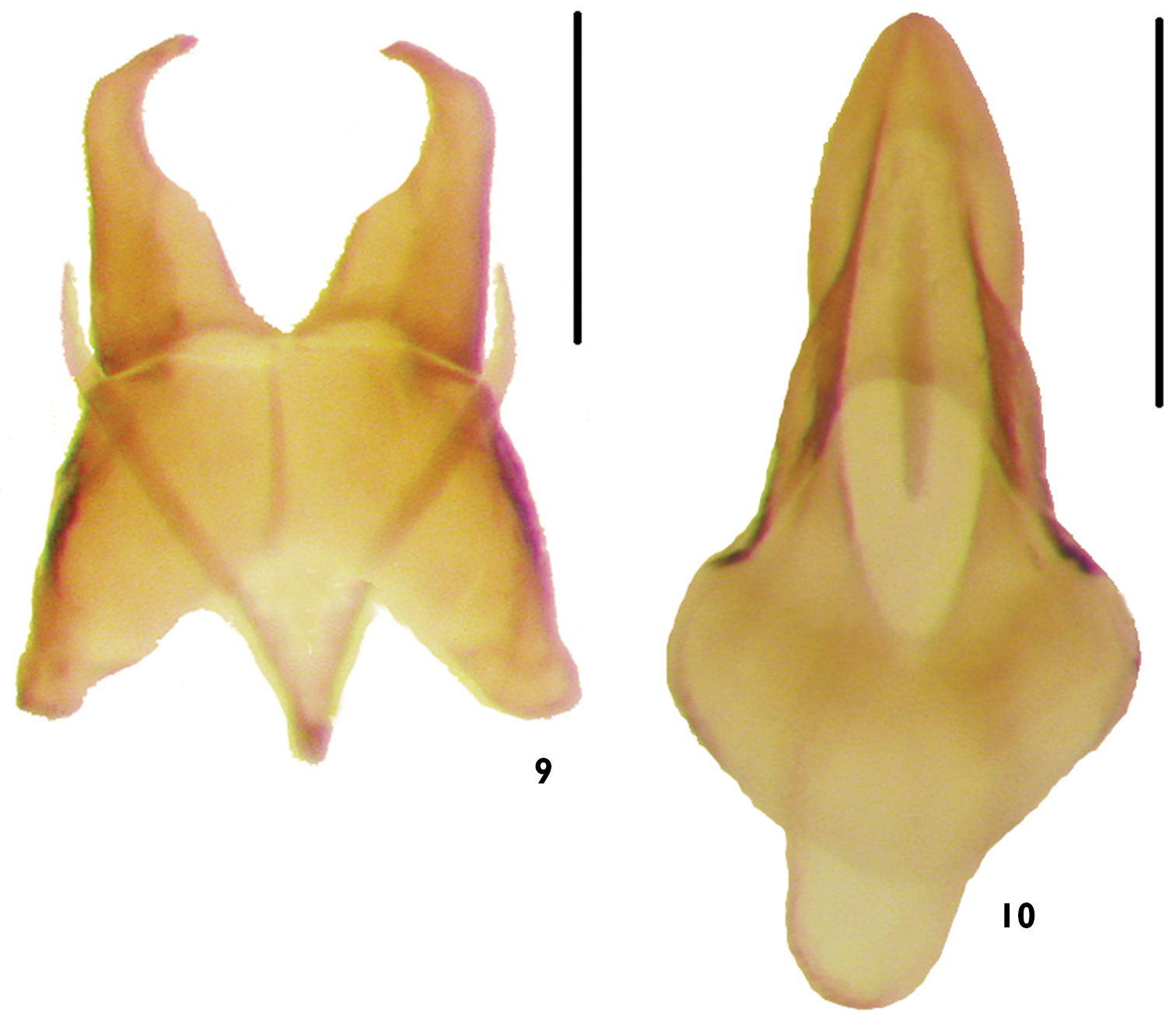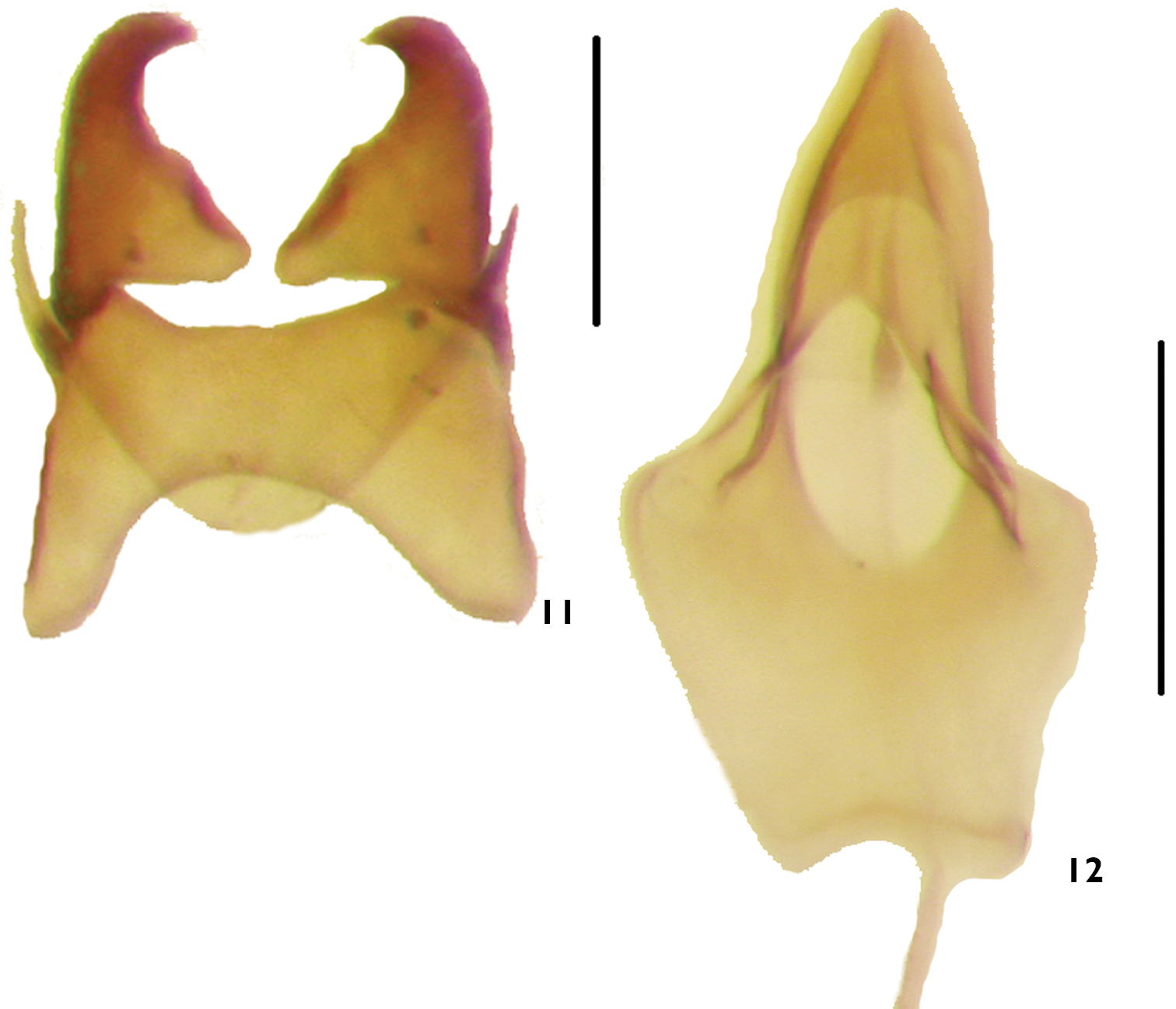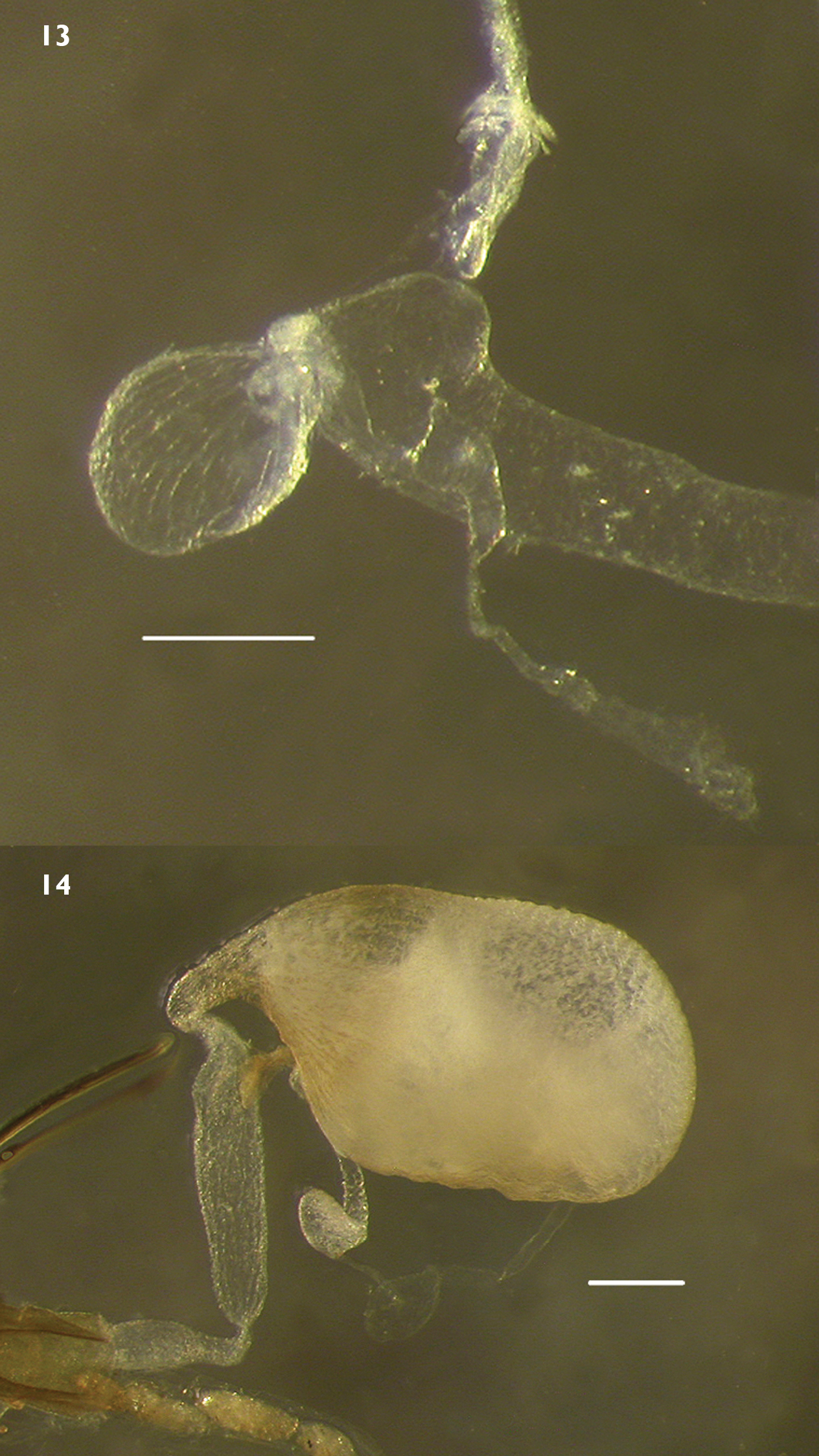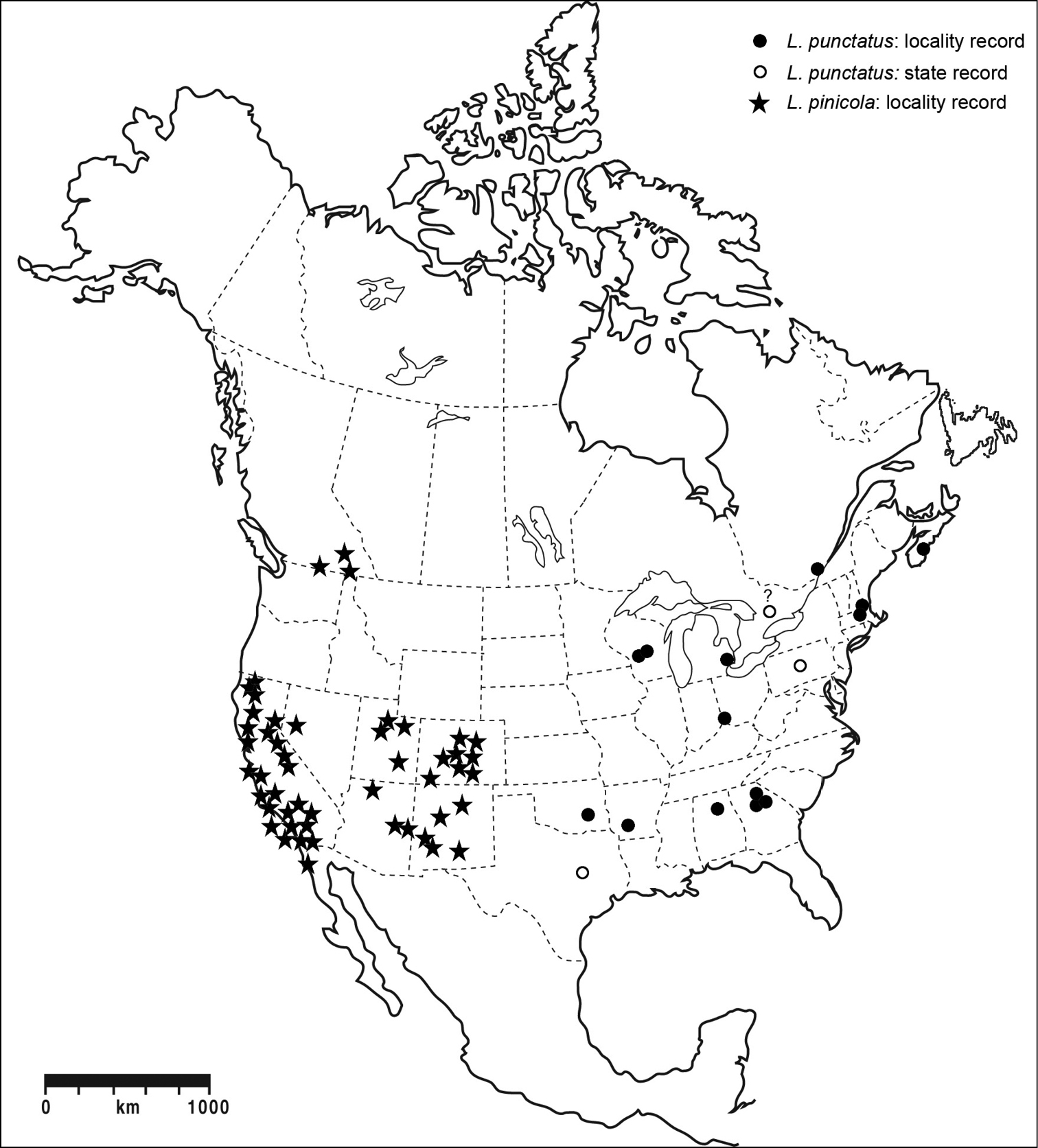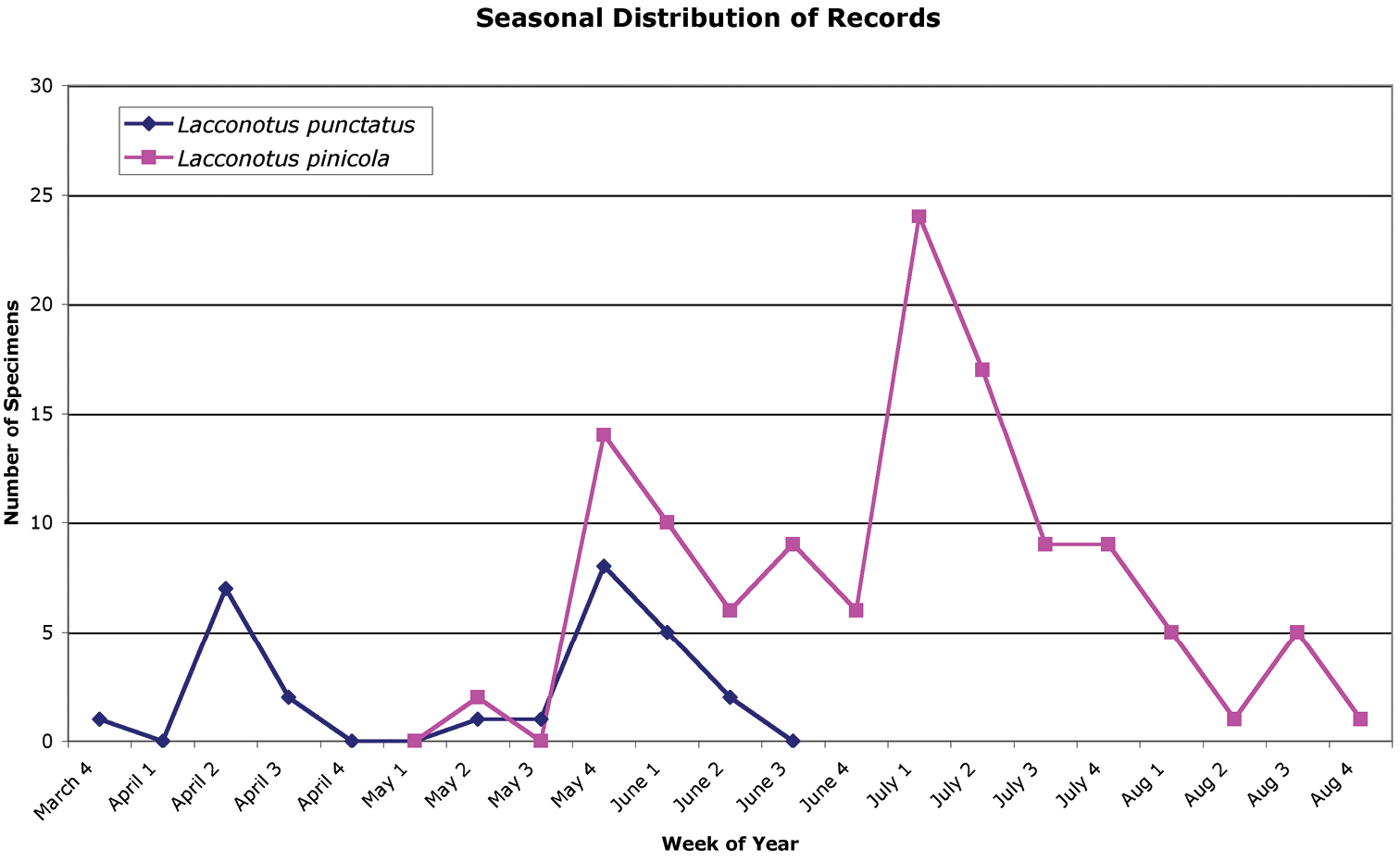






(C) 2012 Darren Pollock. This is an open access article distributed under the terms of the Creative Commons Attribution License 3.0 (CC-BY), which permits unrestricted use, distribution, and reproduction in any medium, provided the original author and source are credited.
For reference, use of the paginated PDF or printed version of this article is recommended.
Lacconotus LeConte, the sole Nearctic representative of the eurypine Mycteridae, is revised, based on morphological features of adults. The following syn. n. is proposed: Lacconotus pallidus Van Dyke, 1928 = Lacconotus pinicola Horn, 1879. The former is a light-colored form with a southern California distribution. A subgen. n., Alcconotus, is described for Lacconotus pinicola, producing the following comb. n.: Lacconotus (Alcconotus) pinicola (Horn). A lectotype is designated for Lacconotus pinicola. A key separating the two subgenera and species is provided, as are photographs and illustrations of salient structures of adults, and maps showing collection localities. Lacconotus punctatus is newly recorded in Alabama, Arkansas, Massachusetts, Oklahoma, Texas, and Wisconsin; Lacconotus pinicola is newly recorded in Arizona and Utah in the USA, and Baja California Norte in Mexico. Phenology information shows a north-to-south gradation in occurrence time.
Coleoptera, Mycteridae, Eurypinae, North America, new records, range extensions
Among the three subfamilies of Mycteridae, the Eurypinae (= Lacconotinae) are the most diverse with 26 genera and 160 species recognized worldwide, the greatest diversity being in New and Old World tropical regions (
According to
This study of Lacconotus was undertaken for several reasons. For some time, it was recognized (Pollock, personal observation) that the eastern and western species of the genus were rather dissimilar structurally; recent collections of specimens, especially through Michael Caterino’s “California Beetle Project”, have added much more material for study; and, it is the first author’s goal to revise all genera of world Mycteridae, including the many presently poorly known genera of Eurypinae.
Natural HistoryAs with many other groups of Tenebrionoidea, and Coleoptera generally, relatively little is known of the specific habits of eurypine Mycteridae. Larvae have been described for only a few species; these descriptions (see references in
The biology of Lacconotus seems typical of eurypines: larvae occur under bark of various tree species.
Other specific details pertinent to natural history, derived from label data or other sources, are given under Lacconotus punctatus and Lacconotus pinicola, below.
Methods and conventionsStandard taxonomic methods were used in this study. Habitus photographs were taken with a Nikon Coolpix 5000® digital camera fitted to a Leica MZ95 stereoscope. Approximately 30 separate photographs were taken for each specimen/structure; these were imported into Combine ZP (
Several measurements were used: HL = length of head from anterior margin of pronotum to labrum; PL = length of pronotum along middle; EL = length of elytron from anterior to posterior extent; GHW = maximum width of head, across eyes; GPW = maximum pronotal width; GEW = maximum width of both elytra; TL = HL + PL + EL.
Label data on type specimens are recorded verbatim, with all label data enclosed in quotes and individual labels separated by a slash (/). Information added by the authors for clarity is enclosed in square brackets ([ ]).
Abbreviations of collections (largely following
AAAC Albert A. Allen Collection, Boise, Idaho, USA
AMNH American Museum of Natural History, New York City, New York, USA
CAS California Academy of Sciences, San Francisco, California, USA
CMNH Carnegie Museum of Natural History, Pittsburgh, Pennsylvania, USA
CNC Canadian National Collection of Insects, Arachnids, and Nematodes, Ottawa, Ontario, Canada
CSCA California State Collection of Arthropods, Sacramento California, USA
CUIC Cornell University Insect Collection, Ithaca, New York, USA
DAPC Darren A. Pollock Collection, Eastern New Mexico University, Portales, New Mexico, USA
EMEC Essig Museum of Entomology, University of California, Berkeley, California, USA
FMNH Field Museum of Natural History, Chicago, Illinois, USA
MCZ Museum of Comparative Zoology, Harvard University, Cambridge, USA
NMNH National Museum of Natural History, Washington, District of Columbia, USA
NSMC Nova Scotia Museum, Halifax, Nova Scotia, Canada
QMOR Collection Entomologique Ouellet-Robert, Université de Montréal, Montréal, Québec, Canada
RBC Rick Buss Collection, Albuquerque, New Mexico, USA
SBMN Santa Barbara Museum of Natural History, Santa Barbara, California, USA
TAMU Texas A & M University, College Station, Texas, USA
UAIC University of Arizona Insect Collection, Tucson, Arizona, USA
UBC University of British Columbia, Vancouver, British Columbia, Canada
UCR University of California-Riverside, Riverside, California, USA
UNHC University of New Hampshire, Durham, New Hampshire, USA
WFBM W.F. Barr Entomological Collection, University of Idaho, Moscow, Idaho, USA
WIRC WisconsinInsect Research Collection, University of Wisconsin, Madison, Wisconsin, USA
IdentificationAdults of Lacconotus can be differentiated with the following key:
| 1 | Dorsal color dark brown to near black, except for variously developed lateral reddish areas on pronotum (Fig. 1) (in some specimens reduced to the extreme posterolateral corners, e.g., Fig. 4); elytral punctation coarse, punctures obvious; antennae short, antennomeres submoniliform; male sex patch large, bulbous, glabrous, and with contrasting pink-red color (Fig. 5); known from eastern North America, west to Texas (Fig. 15) | Lacconotus (Lacconotus) punctatus LeConte |
| – | Dorsal color uniform, light brown (Fig. 3) to nearly black (Fig. 2); punctation of elytra fine, punctures not conspicuous; antennae relatively long, antennomeres longer than wide; male sex patch small, oval, setose, and not distinctly contrasting in color to venter (Fig. 6); known from western North America, east to Colorado and New Mexico (Fig. 15) | Lacconotus (Alcconotus) pinicola Horn |
http://species-id.net/wiki/Lacconotus
[note: “Lacconotus” indicates the character states for subgenus Lacconotus, while “Alcconotus” refers to the corresponding states in subgenus Alcconotus (see below)].
Body elongate oval (TL/GEW 2.8-3.4), parallel-sided to widened posterior of middle, slightly (Alcconotus) to moderately (Lacconotus) flattened dorsally. TL 4.6–7.5 mm.
Head relatively short, narrowed slightly posterior of eyes; eyes moderately large, distinctly convex, inner margins convergent anteriorly; facets moderately coarse, with intrafacetal setae (especially noticeable in Alcconotus); frontoclypeal suture indistinct, indicated by slight furrow only; antennal insertions slightly concealed dorsally by raised lateral margins of frons; labrum transverse, anterior margin straight to shallowly sinuate.
Antennae relatively short (Fig. 1) (Lacconotus) to moderately elongate (Figs 2–3) (Alcconotus), not exhibiting distinct sexual dimorphism; scape and pedicel moniliform (Lacconotus) to slightly elongate (Alcconotus); antennomere 3 elongate, antennomeres 4–10 wider than long, submoniliform (Lacconotus) to elongate, triangular to subserrate (Alcconotus); antennomere 11 narrowed distally; sensilla present on distal surface of antennomeres 5–10.
Dorsal habitus photograph of Lacconotus (Lacconotus) punctatus; female, New Hampshire. TL = 5.1 mm. Photo credit: Darren Pollock, Eastern New Mexico University.
Mandibles relatively short, stout, slightly asymmetrical, apically bidentate; terebral teeth absent, or represented by several minute crenulae; molae approximately equal in size, subquadrate, with slightly developed surface texture; both mandibles with abrupt incision distal of mola; ventral row of microtrichia absent; prostheca distinct, about half length of mandible, inserted near distal edge of mola; maxilla with galea slightly longer than lacinia; galea bluntly rounded distally, relatively densely pubescent; maxillary palpi elongate, apical palpomere securiform (Lacconotus) to slightly cultriform (Alcconotus); inner margins of palpomeres 1 and 2 straight (Lacconotus) to slightly sinuate (Alcconotus); mentum short, about 2 × wider than long, posterior suture straight (Alcconotus) or distinctly arcuate (Lacconotus).
Thorax. Prothorax subquadrate (Figs 1–3), slightly wider than long (GPW/PL = 0.90–1.29); pronotal margins straight and convergent anteriorly, to slightly arcuate and widest near midlength; pronotal disc flat to slightly convex, with variously developed shallow, paired depressions; lateral pronotal carinae absent, margin smooth; posterior margin with pair of small, deep, punctiform pits; prosternum anterior of procoxae short (Lacconotus) to moderately elongate (Alcconotus), surface flat to slightly sunken medially; intercoxal process short, knife-like, extended to about half length of procoxae; procoxae rounded (Lacconotus) to elongate (Alcconotus); procoxal cavities open externally and internally; protrochantin concealed.
Dorsal habitus photograph of Lacconotus (Alcconotus) pinicola; female, Utah. TL = 6.3 mm.<br/> Photo credit: Darren Pollock, Eastern New Mexico University.
Dorsal habitus photograph of Lacconotus (Alcconotus) pinicola (‘pallidus'); female, California. TL = 6.5 mm. Photo credit: Darren Pollock, Eastern New Mexico University.
Elytra elongate, subovate, disc flat (Lacconotus) to slightly convex (Alcconotus), upper surface uniformly and moderately coarsely punctate and setose (slightly more coarse in Lacconotus), setae closely appressed to elytral surface; apical elytral patch present, but not conspicuous dorsally, not contrasting in color with respect to remainder of elytron; epipleuron narrow, traceable only to abdominal ventrite 3 or 4; mesosternum with posterior intercoxal process parallel-sided, extended posteriorly to near posterior extent of mesocoxae; mesocoxae narrowly but completely separated, trochantins exposed; coxal cavities partly closed laterally by mesepimera; metasternum large, convex, anterior margin with indistinct (Lacconotus) to distinct (Alcconotus) process, in contact with posterior mesosternal process; median impressed line distinct to at least half distance to anterior margin of metasternum; metendosternite with long, relatively wide stalk; anterior tendons inserted on anterior margin of metendosternite body; laminae large, produced and somewhat angulate laterally.
Wing (Figs 7–8) fully developed, membrane beyond distinct radial cell moderately short (esp. in Lacconotus); venation similar in both species, but wing membrane and veins relatively darkly pigmented in Alcconotus (Fig. 8), very pale in Lacconotus (Fig. 7); wedge cell present; 3 MP veins reaching wing margin, proximal to CuA+AA; pigmented patches (flecks) present near junction of RP and MP, and near radial cell (Alcconotus), indistinct in Lacconotus.
Legs well developed, similar in relative shape and size on all thoracic segments; middle and hind femora slightly more expanded than front femora; femora relatively slender, but distinctly widened toward midlength; tibiae straight, about same length as femora, tibial spurs very short, equal in length; tarsomeres slender, 5–5-4; all tarsomeres simple ventrally, except for penultimate tarsomere with large ventral lobe; basal tarsomere on hind tarsus subequal in length to other tarsomeres combined; tarsal claws with large blunt tooth.
Abdomen with all ventrites freely articulated, uniformly punctate and setose, except for male sex patch; sex patch of two forms: small, longitudinally oval, setose patch on ventrite 2, not contrasting in color with ventrite (Fig. 6) (Alcconotus); or large, somewhat bulbous, glabrous area occupying and somewhat distorting the shape of ventrite 2, distinctly contrasting in color to dark ventrite surface (Fig. 5) (Lacconotus).
Male genitalia with median lobe dorsal to tegmen; sternite 9 forming ring-like sclerite, U-shaped in Alcconotus (Fig. 11), Y-shaped in Lacconotus (Fig. 9); tegmen relatively short, stout; basale broader than long, proximal margin deeply emarginate; length of apicale subequal to that of basale (along lateral margins); parameres of apicale short (Fig. 11) (Alcconotus) to slightly elongated (Fig. 9) (Lacconotus), with distal, inwardly-directed hook; median lobe (Figs 10, 12) stout, longer than tegmen; ventral side deeply emarginate, dorsal side proximally subquadrate, laterally produced, explanate; apex of median lobe triangular, relatively blunt.
Female genitalia with elongate, flexible, and only slightly sclerotized ovipositor; coxites 4-segmented, sparsely setose; distal segment short, distinctly more sclerotized than remainder of coxite; styli short, setose, with several very long distal setae; dorsal and ventral baculi well developed, extended to base of coxites; spiculum long, far exceeding length of segment 8; bursa copulatrix small (Fig. 13) (Lacconotus) to very large (Fig. 14) (Alcconotus), separated from vagina by narrow constriction, without conspicuous surface texture; spermatheca present, inserted near or at base of bursa, with elongate spermathecal gland.
http://species-id.net/wiki/Lacconotus_punctatus
Figs 1, 4–5, 7, 9–10, 13, 15–16holotype, male, labeled: “[pink circle] / ♂ / Type 4760 / Lacconotus punctatus Lec. / HOLOTYPE ♂ Lacconotus punctatus LeC. exam. Pollock 2000”, in MCZC.
This species is easily diagnosed by the following characteristics: body color dark piceous to near black, pronotum with reddish margins and black center (Figs 1, 4); antennae relatively short, antennomeres submoniliform; male sex patch on ventrite 2 bulging, glabrous, yellow-orange, contrasting with dark color of venter (Fig. 5); distribution in eastern North America (Fig. 15).
To general features of Lacconotus (see description, above) the following can be added: TL 4.4–5.8 mm; GEW 1.5–2.0 mm; TL/GEW 2.9–3.3. Dorsal body surface uniformly piceous to near black, except for lateral areas of pronotum red-orange (Fig. 1); extent of light area varying, from extreme posterolateral corners to fully 2/3 of pronotal disc; ventral surface and legs dark, piceous to near black; antennomeres 5–10 short, distinctly wider than long, submoniliform; antennal sensilla completely annular, covering entire distal antennal surface, around insertion point of next antennomere; wing very pale, veins present, but inconspicuous; male sex patch (Fig. 5) very large, occupying entire length of second ventrite, prolonged onto ventrite one, glabrous and bulging ventrally; color of sex patch yellow-orange, distinctly contrasting background color of ventrite; tegmen of male genitalia (Fig. 9) moderately elongate, parameres of apicale relatively slender; bursa copulatrix (Fig. 13) spherical, small.
Lacconotus punctatus is newly recorded in Alabama, Arkansas, Massachusetts, Oklahoma, Texas, and Wisconsin (see Appendix A). Published records of Lacconotus punctatus are from Ontario (
The new records above make clear that the distribution of Lacconotus punctatus in North America is much wider than previously known (Fig. 15). Less than a decade ago,
There is also much more information on the range of habitats that Lacconotus punctatus occupies. In Nova Scotia a specimen was found in a mixed forest of white pine (Pinus strobus L.), balsam fir (Abies balsamea (L.) Mill), eastern hemlock (Tsuga canadensis (L.) Carr.), and maple (Acer spp.) (
In Georgia, specimens were collected in mature bottomland hardwood forests in April with flight intercept traps in the forest canopy (
The phenology information that is available (Fig. 16) indicates that adults can be found between 31 March and 16 June. Specimens from southern areas (i.e., Georgia) were found in mid April (
Forebody of Lacconotus (Lacconotus) punctatus, dark form. Photo credit: Darren Pollock, Eastern New Mexico University.
Male sex patch of species of Lacconotus 5 Lacconotus (Lacconotus) punctatus, scale bar = 0.75 mm; 6 Lacconotus (Alcconotus) pinicola, scale bar = 0.25 mm. Photo credit: Darren Pollock, Eastern New Mexico University.
Wing of species of Lacconotus 7 Lacconotus (Lacconotus) punctatus, wing length = 4.5 mm 8 Lacconotus (Alcconotus) pinicola, wing length = 5.1 mm. Photo credit: Darren Pollock, Eastern New Mexico University.
Male genitalia of Lacconotus (Lacconotus) punctatus 9 tegmen 10 median lobe. Scale bar = 0.25 mm. Photo credit: Darren Pollock, Eastern New Mexico University.
urn:lsid:zoobank.org:act:7F51E3D0-3408-4469-BC83-EFD22E47750F
Lacconotus pinicola Horn, by present designation.
a partial anagram of Lacconotus, in which its species was formerly placed.
See description above, for Lacconotus; characteristics unique to Alcconotus are indicated with the alternatives for Lacconotus (s. str.).
http://species-id.net/wiki/Lacconotus_pinicola
Figs 2–3, 6, 8, 11–12, 14, 15–16(Lacconotus pinicola, all in MCZC).—lectotype (here designated), female, labeled: “Veta Pass 27.6 Col / 592 / [red] Type 7976 / [handwritten] Lacconotus pinicola (Schwz) / J.L. LeConte Collection / LECTOTYPE ♀ Lacconotus pinicola
(Lacconotus pallidus, all in CAS).—holotype, male (CAS type # 2585), labeled “Mt. Wilson Cal. 6.13.3 / 7701 / Van Dyke Collection / Holotype [along left margin of label covered in red ink] ♂ Lacconotus pallidus Van Dyke". ALLOTYPE, female, labeled "Carmel, Monterey Co VI-4-1916 Cal. / Van Dyke Collection / Allotype [along left margin of label covered in red ink] ♀ Lacconotus pallidus Van Dyke". Four PARATYPES. Male, labeled "Carmel, Monterey Co VI-4-1916 Cal. / Van Dyke Collection / Paratype [along left margin of label] ♂ Lacconotus pallidus Van Dyke". Male, labeled "ParaisoSpgsCal V.28 1924 L.S. Slevin / L.S. Slevin Collection / Paratype [along left margin of label] Lacconotus pallidus Van Dyke". Female, labeled "ParaisoSprings V.31 1916 Cal. / L.S. Slevin Collection / Paratype [along left margin of label] Lacconotus pallidus Van Dyke". Female, labeled "Paraiso Springs V.29 1916 Cal. / CHAMISAL / L.S. Slevin Collection / Paratype [along left margin of label] Lacconotus pallidus Van Dyke".
Lacconotus (Alcconotus) pinicola may be distinguished from Lacconotus punctatus by the following features: body color ranging from testaceous to dark brown, uniform dorsally (Figs 2–3); antennae relatively long, subserrate; male sex patch on ventrite 2 small, oval, densely pubescent (Fig. 6); distribution in western North America (Fig. 15).
(see
Male genitalia of Lacconotus (Alcconotus) pinicola 11 tegmen 12 median lobe. Scale bar = 0.25 mm. Photo credit: Darren Pollock, Eastern New Mexico University.
Internal female genitalia of Lacconotus 13 Lacconotus (Lacconotus) punctatus 14 Lacconotus (Alcconotus) pinicola. Scale bar = 0.25 mm. Photo credit: Darren Pollock, Eastern New Mexico University.
Distribution of Lacconotus (Lacconotus) punctatus and Lacconotus (Alcconotus) pinicola in North America and Mexico.
Phenology of Lacconotus (Lacconotus) punctatus and Lacconotus (Alcconotus) pinicola in North America and Mexico.
Lacconotus (Alcconotus) pinicola is newly recorded from Arizona, Utah, and Baja California Norte in Mexico (see Appendix A). Published records of Lacconotus pinicola are from British Columbia (
A number of specimens examined were found on ponderosa pine (Pinus ponderosa Douglas ex. C. Lawson), including one specimen which was recorded as emerging from a dead Pinus ponderosa branch. It has also been found on Engelmann spruce (Picea engelmanni Parry ex Engelm.), scrub oak (Quercus turbinella Greene), and cherry (Prunus sp.). Specimens have been collected at UV lights, with malaise and flight-intercept traps, and by beating vegetation.
We extend sincere thanks to the following, who loaned us specimens and/or gave us valuable advice: Albert A. Allen (Boise, Idaho), Adam Brunke (University of Guelph), Rick Buss (Albuquerque, New Mexico), Michael Caterino (Santa Barbara Museum of Natural History), Louise Cloutier (Université de Montréal), Donald Chandler (University of New Hampshire), Chris Cutler (Nova Scotia Agricultural College), Mike Ivie (Montana State University), David Kavanaugh (California Academy of Sciences), Serge Laplante (Canadian National Collection of Insects, Arachnids, and Nematodes), Stéphane Le Tirant (Insectarium de Montréal), Brad Hubley (Royal Ontario Museum), Edward Riley (Texas A&M University), Michael Ulyshen (USDA Forest Service, Mississippi), and Daniel Young (University of Wisconsin) for their assistance. DAP thanks the administration of Eastern New Mexico University for their continued support of faculty research. CGM thanks M. Rudy Haase for his generous support. This work has been assisted by the Board of Governors of the Nova Scotia Museum.
Lacconotus (Lacconotus) punctatus LeConte
CANADA: NOVA SCOTIA: Lunenburg County: Bridgewater, 16 June 2004, G. Selig, adjacent to mixed forest (NSMC, 1); QUEBEC: Montreal Island, 24 May 1902 (CUIC, 1).
UNITED STATES: ALABAMA: Jefferson County: Rocky Ridge, 17 April 1982 (AAAC, 1); Rocky Ridge, 31 March 1982, T. King, (AAAC, 1). ARKANSAS: Hempstead County: Hope Upland Wildlife Management Area (33°44'20"N; 93°38'59"W), 13 April 2003, J.P. Gruber, swept from low foliage in mixed forest/old field (1, WIRC); MASSACHUSETTS: Middlesex County: Tyngsboro, H.C. Fall collection, (MCZ, 1); state record only, (MCZ, 1). MICHIGAN: Wayne County: Detroit, Hubbard & Schwarz collection, (NMNH, 1). NEW HAMPSHIRE: Strafford County: 1 mi. SW Durham, 5 June 1981, 25 May 1982, 27 May 1988, 29 May 1988, 31 May 1988, 5 June 1990, water tower, W.J. Morse (DAPC, 7); 1 mi. SW Durham, 30 May 1982, 3 June 1982, W.J. Morse, water tower (MCZ, 2); 1 mi. SW Durham, 21 May 1982, D.S. Chandler, water tower (DAPC, 1). OKLAHOMA: Latimer County: April 1985, K. Stephan, beating dead oak (1, TAMU); Latimer County: May 2001, K. Stephan, ultra-violet light (1, TAMU). PENNSYLVANIA: state record only, H. Ulke collection, (CMNH, 1). TEXAS: state record only, H. Ulke collection, (CMNH, 1). WISCONSIN: Monroe County: Ft. McCoy, 1 mi. west of Big Rock, 12–15 June 1997, J.A. Maxwell, oak savanna, flight intercept trap (WIRC, 1); Juneau County: Necedah National Wildlife Refuge, 30 May 1996, 6 June 1996, K. Pope, flight intercept trap (WIRC, 4).
Lacconotus (Alcconotus) pinicola Horn
CANADA: BRITISH COLUMBIA: Kaslo, 8 July, A.N. Caudell (NMNH, 1); Creston, 19 July 1946, G. Stace Smith (UBC, 1); Osoyoos, 2 July 1948, R. Scott, at light (UBC, 1).
MEXICO: Baja California Norte. Ensenada: S[ierr]a Juarez, 3.6 mi. SSE El Rayo, 2.vii.1960, E.L. Sleeper, (CASC, 1).
UNITED STATES: ARIZONA: Apache or Navajo County: McNary, 6 July 1945, F.H. Parker (UAIC, 1); Apache County: White Mts., 25 July 1944, Parker (UAIC, 1); Coconino County: 22 mi. S. Jacob Lake, De Motte Park cmpgrnd, 8700', 17 July 1969, L.N. & C.J. Bell, (CAS, 1). CALIFORNIA: [“pallidus" form] Fresno or Tulare County: Kings Canyon N[ational] P[ark], 24 June 1955, P.S. Bartholomew (CAS, 1); Kern County: Tehachapi Mts., Antelope Canyon, 18 July 1976, 6000 ft. (UCR, 2); Los Angeles County: Santa Catalina Island, Blackjack Rd. (33.3919°N, 118.4001°W), 17 June 2008, Caterino & Chatzimanolis (1, SBMN); Santa Catalina Island, nr. Echo Lk., (33.3974°N, 118.3946°W) 18 June 2008, Caterino & Chatzimanolis (1, SBMN); Angeles National Forest, Ruby Canyon (34.6060°N, 118.5523°W), 22 June 2007 (1, SBMN); Angeles National Forest, Big Dalton Canyon (34.1811°N, 117.7978°W), 13–23 June 2007, Caterino & Chatzimanolis, flight intercept trap (1, SBMN); Angeles National Forest, Tanbark Flat (34.2048°N, 117.7611°W), 23 June 2007, Caterino & Chatzimanolis, at light (1, SBMN); Muchmore, 29 July 1920, (MCZ, 1); Tanbark Flat, 30 June 1950, B. Adelson, at electric light (EMEC, 1); Tanbark Flat, 24 June 1950, H.M. Graham, (EMEC, 1); Santa Monica Mts., Fryman Canyon, 25 May 1991, J. Rifkind (WFBM, 1); county record only (NMNH, 1); Madera County: Bass Lake, 3 June 1942, Pinus ponderosa (TAMU, 1); S[ierra] Madre, June, (CAS, 1); Mt. Lowe, June (CAS, 2); Madera County: Bass Lake, 3 June 1942, Pinus ponderosa (TAMU, 1). Marin County: Phoenix Lake, 30 May 1927, H.H. Kelfer (CAS, 1); San Gabriel Mts., 5 June 1910, 3500 ft. (MCZ, 1); Mt. Wilson, 6 November 1904, 23 July 1905, 5 June 1917, (MCZ, 2; NMNH, 1); Mt. Wilson, 29 June 1940, G.P. Mackenzie, (UCRC, 1); Pasadena, 29 May 1897, 31 May 1897, June 1922, 22 June 1902, (MCZ, 5); Pasadena, 2 July 1926, (NMNH, 1); Pasadena, May, (CAS, 1; AAAC, 1); Pasadena, A. Fenyes, (CMNH, 3); Pasadena, (CUIC, 1; NMNH, 1; FMNH, 2); Pom[ona?] Mts., 6 October 1893, (MCZ, 1); Sequoia Nat. Park, Potwisha, 25 May 1929, 3000–5000 ft. (CAS, 1); Los Gatos, Hubbard & Schwarz, (NMNH, 1); Santa Cruz Mountains, July (FMNH, 2);Fairfax, 18 June 1939 (CAS, 1); Monterey County: UC Big Creek Reserve, Highlands Camp (36.062°N, 121.571°W), 31 May–8 June 2003, M. Caterino, flight-intercept trap (1, SBMN); Paraiso Springs, 31 May 1916, (CAS, 1); Paraiso Springs, 9 June 1932, L.S. Slevin (CAS, 1); Napa County: N. side Howell Mt., 2 mi. NNE Angwin, 5 June 1978, H.B. Leech, emerged ex dead branch of Pinus ponderosa, 1300 ft. (CAS, 1); Orange County: Silverado Cyn., 22 June 1958, E.L. Sleeper (CAS, 1); Riverside County: James Reserve (33.8081°N, 116.7784°W), 15 July 2006, Caterino & Chatzimanolis (1, SBMN); San Bernardino County: Oak Glen, 26 July 1967, M.J. Wargo (CDAE, 1); Gobbler's Knob (34.3116°N, 117.5835°W), 3 July 2005, M. Caterino (6, SBMN; 1 AAAC); Forest Home, 14 June 1928 (CAS, 1); [?Big] Bear Lake, 18 May 1919 (CAS, 1); San Diego County: Poway, F.E. Blaisdell (CAS, 1); San Luis Obispo County: Los Padres National Forest, Cuesta Ridge (35.3630°N, 120.6573°W), 9 July 2008, Caterino & Polihronakis (1, SBMN); Santa Barbara County: UC Sta. Cruz Isl. Res. (34.0013°N, 119.7512°W), 6 June 2005, M. Caterino & J. Jacobs, (SBMN, 1); UC Sta. Cruz Isl. Res. (34.0013°N, 119.7967°W), 6 June 2005, M. Caterino & J. Jacobs, (SBMN, 1); UC Sta. Cruz Isl. Res. (33.9963°N, 119.7281°W), 5–7 June 2005, Lindgren trap, M. Caterino & J. Jacobs, (SBMN, 1); UC Santa Cruz Island Res., Cañada del Puerto (34.0019°N, 119.7127°W), 13 May 2009, Caterino, Chatzimanolis, Hopp & Polihronakis, (SBMN, 1); UC Sedgwick Reserve (34.7246°N, 120.0351°W), 14 May 2005, M. Caterino, beaten from Prunus, (SBMN, 1); Los Padres National Forest, Fremont Tr. (34.5158°N, 119.8069°W), 19–27 June 2001, Malaise, E.I. Schlinger & S. Regan, (SBMN, 2);Freemont Tr. nr. Painted Cave, 8–15 July 2001, E. Schlinger & S. Regan, malaise trap (SBMN, 1); Arroyo Hondo Preserve, 25 mi. W of Santa Barbara (34.486°N, 120.135°W), 2 July 2003. M. Caterino (1, SBMN); Los Padres National Forest, 15 mi. NW of Santa Barbara, west of Camino Cielo (34°30'N, 119°49.8'W), 4 July 2001 M. Caterino, 900 m (1, SBMN); Los Padres National Forest, 5 mi. north of Santa Barbara (34°29.58'N, 119°41.13'W), 5 July 2001, M. Caterino, 1050 m (2, SBMN); 3 mi. N. Refugio Beach, 28 June 1965, J.R. Stephenson (CAS, 1); Santa Clara County: Los Gatos, Hubbard & Schwarz (NMNH, 1); Santa Cruz Mountains, July (FMNH, 2); Santa Cruz County: 4 mi. SE Big Basin, 4 July 1967, A.R. Gillogly, uv light (TAMU, 2); Tulare County: Sequoia Nat. Park, Potwisha, 25 May 1929, 3000–5000 ft. (CAS, 2); Tuolumne County: Phoenix Lake, 30 May 1927, H.H. Kelfer (CAS, 1); CALIFORNIA: [“pinicola" form] Butte County: 2.8 mi NW French Creek, 15 July 1990, light trap, W.D. Shepard & C.B. Barr, (CAS, 2). El Dorado County: Blodgett Forest, 18 mi. E. Georgetown, 1 July 1967, J. Powell, at light (EMEC, 1); Pollock Pines, 27 July-18 August 1987, R.B. Flint, blacklight (CSCA, 1); Placer County: Tahoe National Forest, Pineland Drive 3.2 km S. of Tahoe City, 1900 m, 30 July 1983, T.W. Davies (CAS, 1); Siskiyou County: 9 mi. NW Happy Camp, blacklight trap, 22 August 1982, F.D. Horn (CSCA, 1); Trinity County: Carrville, 10 June 1913, (CAS, 1); Tuolumne County: 4 mi. W. Pinecrest, 12 July 1961, J.G. Rozen (AMNH, 4); Lyons Dam Rd., 29 August 1968, W.F. & F.C. Tyson, attracted to black light (NMNH, 1); COLORADO: Boulder County: Longs P[ea]k Inn, 13 July 1926, E.C. Van Dyke, 9000 ft. (CAS, 1); Ward, July 1905, CKU (MCZ, 1); Custer County, T.D.A. Cockerell (NMNH, 1); Delta County: Paonia, 14 June 1926, E.C. Van Dyke (CAS, 1); El Paso County: Waldo Canyon, 25 June 1916, W.D. Edmonston, Pinus ponderosa (NMNH, 1); Manitou [?Springs], 23 June 1926, E.C. Van Dyke (CAS, 1); Grand or Jackson County: Rabbit Ears [Pass], 24 July 1930, P[icea] engelmanni (NMNH, 1); Huerfano County: [La] Veta Pass, 21 June, Hubbard & Schwarz (NMNH, 1); [La] Veta Pass, 1 July, F.C. Bowditch Coll. (MCZ, 1); La Plata County: Durango, 10 July 1968, E.C. Becker, beating scrub oak, 7000' (CNC, 5); Durango, 7 July 1968, E.C. Becker, 7500' (CNC, 3); Durango, Horse Canyon, 21 July 1968, E.C. Becker, beating scrub oak, 7000' (CNC, 1); Teller County: Florissant, 7 July 1902, S.A. Rohwer (MCZ, 1); County unknown: Florentine, July 1879, Pourtales (MCZ, 1); county unknown, Pike Nat. For, Top-of-the-World Camp, 7 August 1976, B.F. & J.L. Carr (CNC, 1); State record only, Ulke Collection (CMNH, 1; MCZ, 1). NEW MEXICO: Bernalillo County: Albuquerque, 29 May 1994, 10 June 2007, R. Buss, UV light (2, RBC); Socorro County: Bear Trap Camp, 28 mi. SW Magdalena, 7 July 1965, F. P. & M. Rindge, 8500' (AMNH, 1). Lincoln County: Cedar Creek, 5 miles N. Ruidoso, 2 July 1961, F., P. & J. Rindge, 7500' (AMNH, 1); Holman Pass, NW of Holman, C.C. Hoff, (AMNH, 1); State records only, Ulke Collection, (CMNH, 3); F.A. Eddy Collection (MCZ, 2). UTAH: Garfield County: Lonesome Beaver, Henry Mts., 25 July 1968, A.T. Howden, 7500' (CNC, 1); Salt Lake County: 6.4 km E. Granite, R.F. Rockwell, Wasatch-Cache National Forest Survey (40°34'20"N; 111°43'47"W), 21 July 1998, 29 July 1998, 5 August 1998, 22 August 1998, 1945m, uv light trap (CMNH, 12); Utah County: Squaw Peak near summit, 5.3 km SSE Springdell, (40°16'57"N; 111°36'19"W), 16 July 1998, R.F. Rockwell (Uinta National Forest Survey), grassy knoll, 2390 m, uv light trap (CMNH, 1); American Fork Canyon, near mouth, 8.0 km N. Pleasant Grove (40°26'08"N; 111°43'45"W), 12 August 1998, R.F. Rockwell (Uinta National Forest Survey), 1580 m, uv light trap (CMNH, 1).
